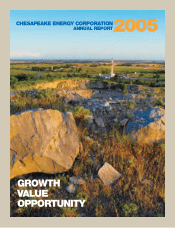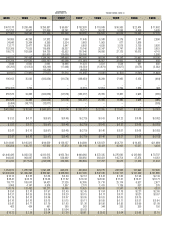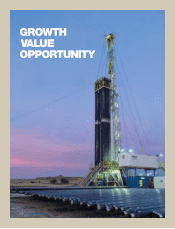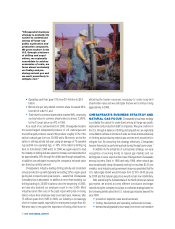Chesapeake Energy 2005 Annual Report Download - page 9
Download and view the complete annual report
Please find page 9 of the 2005 Chesapeake Energy annual report below. You can navigate through the pages in the report by either clicking on the pages listed below, or by using the keyword search tool below to find specific information within the annual report.
industrial demand to less cost-sensitive electrical power
generation demand; and
•production would soon reach a peak from which there would
be no recovery, regardless of higher prices or improved
technology.
These trends became evident when we studied U.S. oil production
history and then predicted that U.S. natural gas production would
likely follow a similar bell-shaped curve of ramping up to a historic
peak (1970 for oil, 2001 for natural gas) and then slowly but steadily
declining thereafter. We also reasoned that the major oil companies
would begin withdrawing from the search for increasingly scarce
natural gas reserves in North America and refocus their natural gas
strategies on building global natural gas franchises around more
abundant worldwide natural gas reserves that could be transformed
into liquefied natural gas (LNG).
As the majors began de-emphasizing their search for new natural
gas reserves in U.S., we felt certain the 35% of U.S. natural gas
production the majors represented would decline at a rate that would
surprise many industry observers. In fact, over the past five years,
the majors’ U.S. natural gas production has declined by a stunning
one-third. It also seemed clear to us that the smaller independent
E&P companies would not be able to increase their own natural gas
production enough to overcome the majors’ production declines.
Accordingly, we decided that Chesapeake should position itself
to be a first mover to take advantage of this opportunity. To that end,
we adopted four objectives:
•acquire all of the existing natural gas production and reserves
we could afford;
•lease all the potentially natural gas productive acreage we
could identify;
•hire all of the talented landmen, geoscientists and engineers
we could find; and
•focus exclusively onshore in the U.S., safely away from
hurricanes and geopolitical unrest.
Over the past eight years, we have accomplished all of these
objectives. Meanwhile, with the help of higher oil prices, natural gas
prices have risen to levels 600-800% greater than they were in 1998
and early 1999. More importantly, assuming normal weather patterns,
natural gas demand is likely to exceed supply and continued natural
gas price strength is probable for years to come. As a result of
anticipating these trends and getting ahead of our competition,
Chesapeake is very well-positioned for success in the years ahead.
GROWTH, VALUE AND OPPORTUNITY With
this context in mind, I now focus on the centerpiece of this letter –
a discussion of why we believe Chesapeake offers the best combination
of growth, value and opportunity in the industry.
GROWTH First and foremost, Chesapeake is a growth
company. At the time of our IPO in 1993 when we only produced
10 mmcfe per day, we were clearly a growth through the drillbit
company in an industry focused primarily on acquisitions. Even
though our production is now 150 times larger, we remain a growth
through the drillbit company. In 2005, our organic growth (that is,
through the drillbit) was 12%, which is exactly what our five-year
average organic growth rate has been and which we believe is the
highest in the U.S. mid and large-cap E&P sector during
that period.
“Natural gas price
strength is probable
for years to come. As
a result of anticipating
these trends and
getting ahead of
our competition,
Chesapeake is
very well-positioned
for success in the
years ahead.”
CHK 2005 ANNUAL REPORT 5






















